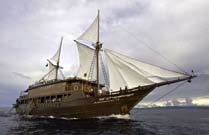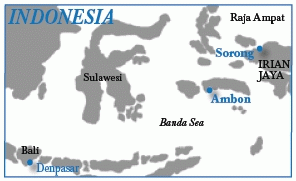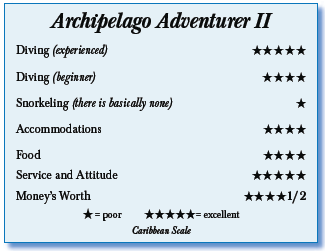Archipelago Adventurer II, IndonesiaContents of this Issue: Archipelago Adventurer II, Indonesia Little Cayman, Maui, Grenadines… Thailand Violence Affects Lembeh Peter Hughes Leaves Peter Hughes Behind At Indonesia’s Triton Bay, the Locals Are Restless Price-Fixing Dive Shops on Catalina Island The Best Summer Read for Divers is Available June 8 Why Divers Get Bad Deals on Life Insurance What’s More Dangerous, the Rebreather or the Diver? Night Time Raid on Fiji’s Lagoon Resort, Beqa Divers Editorial Office: Ben Davison Publisher and Editor Undercurrent 3020 Bridgeway, Suite 102 Sausalito, CA 94965 Raja Ampat: where one feels like a king from the June, 2010 issue of Undercurrent
Dear Fellow Diver: Within an hour of arriving at Ambon Island airport in Indonesia’s South Moluccas, I was whisked from Maluku Divers’ new resort on the outskirts of the harbor to the Adventurer II and to one of this area’s famous muck dives. Called Air Manis (a.k.a. the Fishing Factory), it’s a pier loaded with strange and amusing creatures. Observing a beaky dragon sea moth waddling on its winged pectoral fins, a pair of harlequin shrimp dragging away a sea urchin, and a variable neon slug with an intense red-orange margin that seemed to have its own power source, I knew I’d arrived at a world-class diving destination. I was ready for my 10-day itinerary from Ambon to Sorong. The Adventurer II is a traditional Indonesian two-masted schooner, 35 meters of rich, lustrous teak and mahogany, which in yesteryear could have appropriately flown the skull and crossbones. Its sails are only raised for show or when the craft’s single screw stops turning. It’s kept spotless by 22 pleasant, courteous and hardworking crewmembers who ensure it runs like an upmarket Swiss watch. Even with the full complement of 18 handpicked Americans, dive and meal schedules went smoothly.
My buddy and I
enjoyed a larger-thanusual
liveaboard cabin
with a tiled shower,
three windows (no portholes
here) and individually
controlled
AC that could bring
the temp down to 65
degrees, a blessing
given the relentless
equatorial heat and
humidity. By the time I
had completed my first
dive each day, my cabin was clean, and fresh sheets and towels in
place. However, several cabins leaked (not
mine) during the episodic heavy rains, not
unexpected in a wooden boat. The crew got
most leaks under control quickly. Each diver was assigned a seat with a storage box underneath. You put on your wetsuit and carry small gear down a widestepped gangplank to one of two assigned zippy, unsinkable aluminum skiffs, each holding nine divers. Tank, fins, weight belt, etc., are waiting on board. At the dive site, the crew helps you don your tank. The assistance I received donning and doffing my gear was almost embarrassing. Between dives, my wetsuit was spirited away for rinsing in a mild and divine-smelling detergent and returned dry and inoffensive. If it was raining, the crew put wet gear in the engine room to dry. The skiffs were not crowded, even when full. Tanks were aluminum 80s, although they have a few oversized tanks. Everyone dove nitrox; the boat’s membrane system made for quick and precise fills. At the end of each dive, I found a clean, dry towel at my seat on the liveaboard. The divemasters allowed as much diver freedom as was consistent with safe diving and scheduling requirements. Being mostly experienced and headstrong photographers, divers went their own way at a dive site. So accommodating was the crew that when one photographer, following a particularly scenic dive, realized her memory card had become corrupted and her images were lost, the DM immediately took her back to the site and let her shoot again. The boat is especially well equipped for photographers, with an outside camera storage shelf with a safety net over it, a dedicated air-conditioned room with battery chargers, a flat-screen TV and individual tables for cleaning and fiddling with photo gear. I don’t know why it’s named “My Reef,” but I’m willing to claim it. Damselfish were in a territorial humbug over a small piece of table coral. An ornate wobbegong shark lazed on the reef like a tatty Persian carpet. A juvenile spadefish spun in graceful circles while estuarine halfbeaks hung out above. At Neptune’s Sea Fan, I was mesmerized by flocks of flitting and feuding anthias that speckled the reef with splashes of lavender, orange, peach and violet. A school of humphead parrotfish, with foreheads looking like the finish on a poorly maintained used car, allowed a close approach. With calm seas, water in the 85-degree range, visibility from 40 to 80 feet and seldom a need to go deeper than 50 feet, conditions for doing four dives a day were nearly ideal. I was disappointed, however, by the swarms of floating plastic bags and other trash. Ambon Harbor was by far the worst. The Raja Ampat diver must keep currents in mind. While the boat endeavored to select sites and times to minimize exposure, currents can become ripping and change directions rapidly and capriciously. Diving here is not for the unfit. And on the matter of fitness and health, Ambon Harbor serves as a sewage system and city dump, meaning divers commonly develop external ear infections and swollen lymph nodes after spending time in the water here.(Take appropriate ear hygiene measures and bring a bottle of Ciprodex Otic or the like.) Ever seen that picture on the front of Burt Jones and Maurine Shimlock’s Diving Indonesia’s Raja Ampat? It’s Boo Rock, a site that rocks with fabulous soft corals in rainbow hues. The “windows” in the rock make a boffo underwater frame for photos, as do the throngs of tropicals drawn to this lush site. At nearby Boo Cape, I experienced both wonder and vertigo at the endless, opposing rivers of yellowtail, bluestreak and lunar fusiliers, midnight snappers and smalltooth emperors. I also spotted frilly Chinese dragon nudibranchs in powder blue and white, as well as a hirsute orangutan crab. The cheery divemasters Made (pronounced maday) and Bram (short for Abraham) pointed out a plethora of creatures I otherwise would have missed -- camouflaged crinoid shrimp; spindly sea spiders; robust and ornate pipefishes hanging snout-down and motionless (“You can’t see us”); and tiny, cheerleader-like pom-pom crabs waving even tinier white anemones in their claws. The Most Magnificently Minuscule Award goes to the pigmy seahorses hiding in sea fans that I could barely see even with my magnifying glass. On one dive a DM stealthily placed a crinoid on the dive beanie of another; it was hilarious to watch him fin about unknowingly sporting the creature like a plume. Food was plentiful, a toothsome mix of Indonesian and “Asian fusion” cuisine that alternated between fish, crustaceans, chicken and meat. A variety of sambals, chili-based sauces, could be added to spice things up; I loved the ones made with fruit and at the upper end of the “heat index.” Breakfast possibilities included eggs, either plain or atop fried noodles or rice, French toast and Indonesian fish or chicken “porridge.” Most meals included fresh fruit and breads baked onboard. Canned soft drinks are available for the taking, while Bintang beer cost $3.50 and mixed drinks $6.50. A measured glass of modest red or white wine was an outrageous $11.50. Imported alcoholic beverages reportedly are taxed at 300 percent but even so, this wine price must violate some international maritime piracy law. Soberly finning at 60 feet along Melissa’s Garden, as pretty and pristine as sites get, I was treated to meadows and cascading plateaus of table and other hard corals flecked with crinoids in an array of yellows, teals, blacks, whites and burgundies. Stands of acropora coral, tipped in powder blue and pink, were home to schools of chromis that darted above and juvenile domino damsels that popped in and out as if driven by a steam calliope. Sheltering underneath were pairs of pennant bannerfish, turning slowly in the water as if obtuse triangles suspended on a thread. Against this delicacy and detail, a massive humphead wrasse cast a wary eye my way as it lumbered past. Oriental sweetlips with kissers that could suck a golf ball through a keyhole rested in the garden’s shade. The scene made me feel privileged to be a diver. At Batanta, along a shallow and featureless black sand slope, I had the good fortune of watching the elusive wonderpus forage along the bottom. Compact and sleek, its rich, brown-reddish color and crisp white markings stood out starkly against the dark sand. Its Latin name, Wunderpus photogenicus, struck me as spot on. Martian-like tiger mantis shrimp obsessively tidied their already immaculate abodes.
Overall, I would rate the Archipelago Adventurer II among the best of many liveaboards I have dived from, and Raja Ampat diving truly is magical and unique. Sadly, there now are about 20 operators diving this national marine park, and as many as 10 at a time have been observed off Misool Island. While this was the only location where I saw other dive boats (three, to be exact), it was the off-season. Like so many other exotic “hot spot” destinations, it’s best to dive it sooner rather than later. -- Doc Vikingo
|

I want to get all the stories! Tell me how I can become an Undercurrent Online Member and get online access to all the articles of Undercurrent as well as thousands of first hand reports on dive operations world-wide
| Home | Online Members Area | My Account |
Login
|
Join
|
| Travel Index |
Dive Resort & Liveaboard Reviews
|
Featured Reports
|
Recent
Issues
|
Back Issues
|
|
Dive Gear
Index
|
Health/Safety Index
|
Environment & Misc.
Index
|
Seasonal Planner
|
Blogs
|
Free Articles
|
Book Picks
|
News
|
|
Special Offers
|
RSS
|
FAQ
|
About Us
|
Contact Us
|
Links
|
3020 Bridgeway, Ste 102, Sausalito, Ca 94965
All rights reserved.


 Dan, the
boat’s majordomo who was fresh from the hospitality
industry in Orlando, was a relaxed,
funny and obliging chap of 25 who easily
could be mistaken for an instructor at a
skateboard park -- pull a wallie, dude.
Dan, the
boat’s majordomo who was fresh from the hospitality
industry in Orlando, was a relaxed,
funny and obliging chap of 25 who easily
could be mistaken for an instructor at a
skateboard park -- pull a wallie, dude. My final dives finished with a bang
at a site called Manta Sandy, where
the four kings of Raja Ampat saw fit
to parade. On each of two dives, the
first manta showed up within 10 minutes.
They did lazy loops over the coral
heads as various cleaner fish assiduously
plied their trade. As I knelt in
the sand, one animal repeatedly passed
over me at arm’s length -- a veritable
manta lap dance. Between rays, the site
offered gardens of spotted garden eels
and barred shrimp gobies standing guard
while commensal blind shrimp partners
tirelessly pushed detritus from their
joint burrow.
My final dives finished with a bang
at a site called Manta Sandy, where
the four kings of Raja Ampat saw fit
to parade. On each of two dives, the
first manta showed up within 10 minutes.
They did lazy loops over the coral
heads as various cleaner fish assiduously
plied their trade. As I knelt in
the sand, one animal repeatedly passed
over me at arm’s length -- a veritable
manta lap dance. Between rays, the site
offered gardens of spotted garden eels
and barred shrimp gobies standing guard
while commensal blind shrimp partners
tirelessly pushed detritus from their
joint burrow.  Diver’s Compass: The Archipelago Adventurer II has various itineraries
depending on the season; the Sorong/Ambon Raja Ampat trips typically
run from mid-October to early April . . . Cabins are $400 per person,
per night, double occupancy . . . Flights to Ambon are available
from various Indonesia airports, including Jakarta and Bali . . . Visa
and MasterCard are accepted but cash, preferably Indonesian Rupiah, is
preferred for tipping . . . The boat has a full line of rental gear,
a well-stocked first-aid cabinet and lots of oxygen . . . The nearest
recompression chamber requires a long flight to either Sulawesi,
Jakarta or Darwin, Australia . . . March air temperatures were 90 degrees in the daytime,
75 degrees at night, both with a higher heat index; that’s the start of the
rainy season so expect at least passing showers (or heavier) daily and somewhat reduced
visibility . . . Website:
Diver’s Compass: The Archipelago Adventurer II has various itineraries
depending on the season; the Sorong/Ambon Raja Ampat trips typically
run from mid-October to early April . . . Cabins are $400 per person,
per night, double occupancy . . . Flights to Ambon are available
from various Indonesia airports, including Jakarta and Bali . . . Visa
and MasterCard are accepted but cash, preferably Indonesian Rupiah, is
preferred for tipping . . . The boat has a full line of rental gear,
a well-stocked first-aid cabinet and lots of oxygen . . . The nearest
recompression chamber requires a long flight to either Sulawesi,
Jakarta or Darwin, Australia . . . March air temperatures were 90 degrees in the daytime,
75 degrees at night, both with a higher heat index; that’s the start of the
rainy season so expect at least passing showers (or heavier) daily and somewhat reduced
visibility . . . Website: 